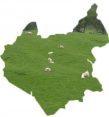Twyford is 15 miles north-east of Leicester and 7 miles south of Melton Mowbray Thorpe Satchville is a neighbouring hamlet within the parish.
Twyford
Early nonconformity
There was just one nonconformist recorded in 1676.[1]John Jeffreies, a Baptist, was holding religious meetings in Somerby and Twyford in about 1705. These were attracting 100 hearers, including four voters.[2] The following year vicar Robert Seagrave reported five male dissenters in the parish (including Thorpe Satchville) out of 107 families. ‘Some parts of their families’ were also nonconformists. They met for worship occasionally in a private house. By 1709 Rev. Seagrave recorded ‘part of six families’ were Presbyterians and ‘Anabaptists’ although there was ‘seldom or never’ any meeting in the parish. In 1712 ‘part of 4 families’ were described as ‘Independents or Anabaptists’, who met together on the second Sunday of every month under John Jefferys, their teacher.[3]
Andrew Peak’s house in Twyford was licensed for religious worship in 1716, as was James Hewerdine’s house in 1736.[4]
No response from Twyford survives to the Meeting House Return of 1829, and it is possible there were no nonconformist congregations meeting in the village at that date.
Wesleyan Methodists
A Wesleyan chapel, which was built in the Gothic style, cost £300 when it was constructed in 1845.[5] It had 60 free seats and 75 other seats. Two services, in the afternoon and evening, were held on Sunday 30 March 1851, attended by 80 and 90 people respectively. The average attendance was 70 in the afternoon and 100 in the evening. A Sunday School also met that afternoon, attended by 23 people, significantly fewer than the usual attendance of around 40.[6] In 1853, a schoolroom was added to the chapel. This was attended by both day scholars and Sunday school pupils.[7]
Thorpe Satchville
Primitive Methodists
A Primitive Methodist congregation began to meet in the mid 1840s, and by the early 1880s were using an ‘old preaching room’. A site was purchased for a new chapel, and in August 1885 the foundation and memorial stones were laid.[8] The chapel opened on 25 October 1885, and had cost £200, although only £125 had been collected at that date, leaving a debt of £75 to be cleared.[9]
Return to Protestant Nonconformity: A-Z
[1] A. Whiteman, The Compton Census of 1676: A Critical Edition (London, 1986), p. 339
[2] Dr Williams’s Library, Evans List, fol 66.
[3] J. Broad (ed.), Bishop Wake’s summary of visitation returns from the diocese of Lincoln, 1706-1715. Part 2, Outside Lincolnshire (Huntingdonshire, Hertfordshire, Bedfordshire, Leicestershire, Buckinghamshire) (Oxford, 2012), 830.
[4] ROLLR, rot. 2v, 4
[5] White, Hist. Gaz. & Dir. Leics. (Sheffield 1846), p. 463
[6] TNA, HO 129/418/16
[7] White, Hist. Gaz. & Dir. Leics. (Sheffield 1863), p. 635
[8]Grantham Journal, 29 Aug. 1885;5 Sept. 1885
[9]Grantham Journal, 31 Oct. 1885.
